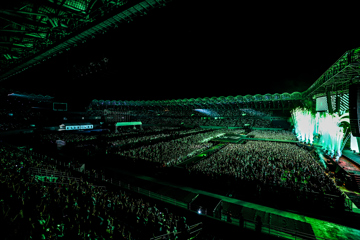Steven Soderbergh's 'Logan Lucky' Is A Hillbilly Heist Film With A Heart Of Gold
'Writer Rebecca Blunt delivers a collection of fun characters, then has nothing bad happen to them.'
LOGAN LUCKY

In Logan Lucky — Steven Soderbergh’s cinema “comeback” — Channing Tatum’s laid-off, down-on-his-luck construction worker scribbles up a bullet-pointed, handwritten list of 10 simple rules for staging a heist. ‘Shit happens’, is #7. And, then, for added measure, #10 is: ‘Remember, shit happens’. These serve not just as a good rules for a heist, but for heist movies. And Soderbergh — who directed Ocean’s 13, which is a movie I forgot actually happened — knows a thing or two about heist movies.
One of the rules of heist movies is, indeed, that things will go wrong. That shit will, sure enough, happen. But one of the other rules of staging a heist-movie, and/or any other thriller, is ‘misdirection’. And, it turns out, the warnings foretold in Tatum’s how-to heist litany are a classic case of misdirection. As in: the list, and the genre itself, primes you for something to go wrong. For shit to happen. Only, here, it never really does.
Don't miss a beat with our FREE daily newsletter
Logan Lucky, it turns out, is the most warm-hearted heist movie you can imagine. There’s no scene where greedy thieves turn on each other. No moment where best-laid plans fall apart. And, best of all, no moment in which everyone pulls out guns and shots get fired. Whilst much of Logan Lucky feels like a Valentine to the US Bible Belt — the West Virginia setting, the NASCAR backdrop, the pig-trotter-bobbin’ redneck county fair, the unironic use of John Denver’s Southern anthem Take Me Home, Country Roads — there’s none of the NRA-evangelism that routinely populates American genre cinema. It’s a multiplex-friendly action movie in which no gun is brandished, no shots are fired, no soul is killed.
When Daniel Craig’s escaped explosives expert — Bond receding behind icy blue contact-lenses and a shock of peroxide hair — sets off a key detonation made from peroxide, salt-substitute, and gummy bears, this moment of MacGyver-ism feels duly symbolic. “What, did you think I’d use dynamite?” Craig says, the question feeling as directed at the audience as anyone herein.
It’s spoken to Tatum and Adam Driver, the brothers behind this “hillbilly heist”. They’re the centre of a film of oddball characters idiosyncratically drawn, and lovingly rendered. Even figures that could normally be played for villainy — Katie Holmes’ snarky/custody-battlin’ ex-wife, her wealthy new beau David Denman, Seth MacFarlane’s energy drink-shilling corporate goon, Dwight Yoakam’s overbearing prison warden, the steely-eyed FBI investigators played by Hilary Swank and Macon Blair — are all depicted with humour, humanity, warmth. Even its most Horse Apples-esque redneck yokels — dipshit brothers played by Brian Gleeson and Jack Quaid — feel more like works of affectionate ribbing than snide caricature.
What results is a film of modest pleasures, a genuine crowdpleaser. Writer Rebecca Blunt delivers a collection of fun characters, then has nothing bad happen to them. Soderbergh mostly stays out of the way, allowing the actors to shine, and for NASCAR’s crazy corporate branding to effectively pay for the film. There’s none of the showy photography or filmmaking fun of Baby Driver, but there’s no awful ending in which countless people get shot, either; no villain rising, again and again, from the dead. Logan Lucky is a genuinely sweet film, a welcome return from a guy who never really went away.
VALERIAN & THE CITY OF A THOUSAND PLANETS

If you’re the kind of person who thinks Avatar is idiotic, Star Wars a run of risible kids-movies, and that Gravity was ruined by its “sunrise over the Ganges” platitudes, Valerian & The City Of A Thousand Planets will likely be a maddening cinematic experience. Luc Besson’s mega-budget intergalactic extravaganza is a work of wild world(s)-building wonder that doesn’t spend much time on character, its vivid visual ambitions bumping up against writing that seems tossed off, clichéd. The film may be in eye-popping 3D, but its characters only come in eye-rolling two dimensions.
Dane DeHaan has done fine work playing a run of pissy, haughty, self-indulgent pricks — from Kill Your Darlings through A Cure For Wellness — but, here, playing some generic nth-generation Han Solo bootleg, his various smirks are pasted over wooden surfer-bro-isms that play like some cut-rate Keanu. Playing opposite him, batting back-and-forth the uninspired ‘sexual tension’ banter, Cara Delevingne is a pair of immaculate eyebrows in search of some emotions to express. We may be in the 28th century, in a far-future populated by thousands of species, but the narrative is still hung on two generically handsome Americans, both variations on ‘smug dick’.
It’s a film in which we visit countless psychedelic worlds, yet half the characters are known by their very-Earthly army rank. Clive Owen plays an evil General who looks like he’s walked out of Spaceballs; John Goodman mo-caps a Jabba the Hutt knock-off; and there’s a trio of zany wizened duck-men that would appear to be bonkers-racist Shylock stereotypes.
The galaxy needs saving. Our main couple are the pair to do it. Rihanna shows up for a burlesque routine. Ethan Hawke plays an intergalactic pimp in a cowboy hat. Delevingne says “I’ve got a bad feeling about this.” The ultimate power in the galaxy proves to be love. The day is saved. People say "Valerian" roughly a hundred times. It’s far more of a slog than anything this bonkers should be.
Besson takes the lessons he learnt — or, indeed, didn’t — with The Fifth Element, and goes to town. Valerian & The City Of A Thousand Planets may be battling a horrible title, growing audience disinterest in 3D, and the feeling of being a knock-off tentpole pic, but that doesn’t stop him rendering a host of memorable images: underwater worlds, marauding monsters, a menagerie of comic creatures. For some, all this visual fun will make this intergalactic rumpus a ride worth taking. For others, the stark contrast between the spectacle and the actual script will make for a painful cinematic experience. You know, by now, which side of the divide you’re on.
THE WALL

It’s the theatre of a war, in a setting so stripped-down it resembles a stageplay. It’s one long, simple standoff in the desert: on one side of a crumbling wall is Aaron Taylor-Johnson’s American soldier. On the other side, in some unseen outpost, is an Iraqi sniper. In the middle, laying on the ground dying, is John Cena. The sniper contacts Taylor-Johnson on the radio, and, with questionable sincerity, hopes that the two can become ‘friends’ before the American dies. And, thereafter, a motionless game of cat-and-mouse ensues.
This is the entirety of the movie. It’s a very theatrical film, in setting and in its silver-tongued, devilish villain. Whilst there’s a sense that director Doug Liman —doing a small-budget side-project in between Tom Cruise joints — believes he’s authoring a prestige picture about the men lost in war, Dwain Worrell’s screenplay is gimmicky enough that, at times, it’s reminiscent of Joel Schumacher’s ridiculous popcorn pic Phone Booth.
Here, another mysterious figure lingers on the other end of a receiver, serving as unseen, all-knowing judge, jury, and executioner. Liman favours a grim realism — its military details precise, its dirt duly dirty — but that only makes the theatrical central device seem evermore stagey.
WIND RIVER

By now, it’s the most familiar of procedural set-ups: a girl is found murdered in a remote outpost, and the ensuing investigation unearths the buried secrets of the local community. And, for the haunted-by-tragedy hero on the trail of the killer, this time, it’s personal!
But, if anyone can breathe life into the most familiar of crime-soap tropes, it’s Taylor Sheridan, the actor-turned-screenwriter — and, now, director — whose first two scripts turned into Denis Villeneuve’s masterclass in building tension, Sicario, and David Mackenzie’s crowd-pleasing bank-robbery-as-financial-crisis-blowback caper Hell Or High Water.
Here, Sheridan is making his directorial debut, and he displays a fine grasp of his material. Its investigation takes place on a vast Indian Reservation in the snowy wilds of Wyoming, and Wind River has a strong sense of place, environment carrying with it an implicit sense of foreboding, which is pushed along by dialogue percolating with socio-politico resentment. Sheridan gives his investigation a sense of momentum, and matches it to a growing air of tension; which, invariably, breaks in an explosion of gunfire.
The emotional beats can feel a little heavy-handed; the well-rehearsed anecdotes about past tragedies almost play as perfunctory, but better is a moment in which the film, unexpectedly, returns back to the past, and plays out a whole revelation-of-what-really-happened movement. He’s aided, in this, by the acting: Jeremy Renner frowning pleasingly throughout, a man wearing scars, loyal to the hostile lands on which he walks; Elizabeth Olsen a winning mixture of naivety and fuck-you defiance; Jon Bernthal doing fine work in a very brief appearance.
It’s, ultimately, an earnest, well-made drama that is proudly heavy going. Its set-up may be the same as the original run of Twin Peaks, but there’s no oddball characterisation or outright comedy. Wind River is as unforgiving, and chilling, as its frosty weather.
AN INCONVENIENT SEQUEL: TRUTH TO POWER

The 2006 documentary An Inconvenient Truth was cinema’s greatest-ever powerpoint presentation, a parade of charts that put the stark facts of global warming in simple, colourful graphs. It was an angry wake-up call, a defiant lecture for anyone who tried to ride the spun rubric of climate change as being a ‘theory’.
A decade on, and you could see why self-professed “reformed politician” Al Gore would want to return to cinema, the scene of his career's most unalloyed success. And, the awkwardly titled An Inconvenient Sequel: Truth To Power comes out with all guns blazing: the intervening years dumping a host of catastrophic super-storms upon the world, rising sea-levels already swamping downtown Miami under a rising tide. Cataclysmic changes are happening around us, on our watch, whilst our corporate overlords and elected powers-that-be verily fiddle in the face of crisis.
Only, then, An Inconvenient Sequel suddenly takes us into that world, and effectively stalls out. Rather than seeing a proselytising Gore, barking out undeniable facts and figures, we see Gore the politician, taking meeting after meeting with powerful men. After showing us mass destruction, death, and grief, directors Bonni Cohen and Jon Shenk chose politicking as being the key dramatic development, and the film’s essential thesis.
Climate change is now, sadly, a political issue, something to be discussed, and negotiated. But, in taking that step, the film swings away from the volatility of storms, and proceeds into something that is, actually, pretty dull to watch.
There’s a grotesque, ironic wrinkle coming from added hindsight, too. As Gore is on the ground in France, helping to grease the wheels of the Paris climate change accord, the film sees the historic agreements as being celebratory, the culmination of one man’s career campaign. Only, with the US having officially withdrawn from their previous agreement, all the successes, here on screen, seem sad, the most pyrrhic of victories. There’s a hastily assembled Trump-era postscript tacked on, but it comes late, and without the deserved venom, the hijacking of the future health of the planet by one reality-TV heel feeling a little more than inconvenient.







